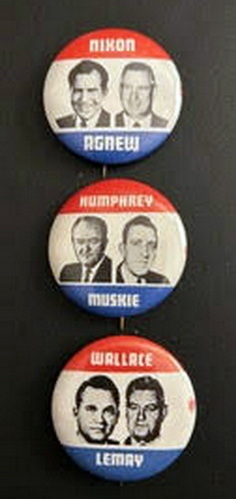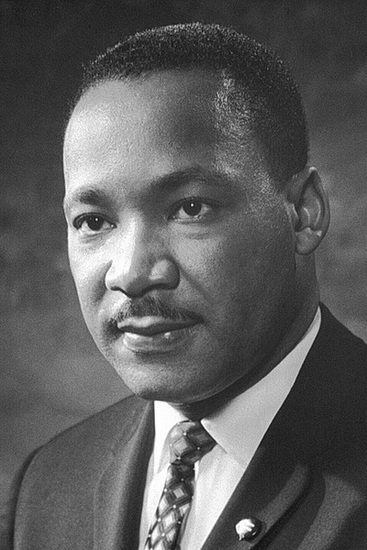
Nixon and Humphrey
1968 was a turbulent and tragic year in the political arena. Iconic civil rights leader Martin Luther King, Jr. was murdered, and then barely two months later, the presumptive Democratic nominee, Robert Kennedy, was assassinated. We saw three political organizations clash, resulting in the last time a third party received electoral votes in a presidential election. We also witnessed a sitting president, Lyndon Johnson, decline to seek another term.

The country was a mess. Anti-Vietnam protests were raging, and the South was enraged by the Civil Rights movement supported by LBJ, a southerner. By the time the Democrats organized for their convention in Chicago, the party’s southern wing bolted to form their own Party, the American Independent Party, as they defiantly opposed the Civil Rights Movement and the end of segregation.
Rioting occurred outside the convention hall while the nominee, Hubert Humphrey, accepted his party’s nomination.
And Then There Was Wallace
The southern Democrats of the American Independent Party chose Governor George Wallace of Alabama as their standard bearer. They considered Wallace a prominent force supporting their ideology, as Wallace was not subtle regarding his views about race. He was adamantly against racial integration, and during his gubernatorial speech in 1963, he declared, “segregation now, segregation tomorrow, and segregation forever.” Martin Luther King labeled him as the “perhaps most dangerous racist in America today“.
On May 15, 1972, Wallace was shot by Arthur Bremer in Laurel, Maryland. Bremer was a 21-year-old from Milwaukee, Wisconsin. He fired several shots at Wallace and struck him multiple times while he was campaigning for the presidential nomination. Wallace was permanently paralyzed from the waist down and spent the rest of his life in a wheelchair. Three bystanders were also wounded. Bremer was initially sentenced in August 1972 to 63 years in prison, but the sentence was reduced to 53 years after an appeal in September 1972. Bremer is currently out of prison but is under mandatory supervision until May 15, 2025.
Republician Comradery
The Republicans came together and nominated perennial candidate Richard Nixon. The liberals wanted Nelson Rockefeller of New York, and the Conservatives considered supporting Governor Ronald Reagan of California. In the end, Nixon was nominated and, with the Democrats split, he was elected in November. Wallace won five states over both major parties, helping to hamper Humphrey’s election chances. Nixon won a landslide in 1972, but then Watergate undid him. Humphrey never ran again.
The Civil Rights Riots
The “civil rights riots” of the 1960s refer to a series of significant outbreaks of civil unrest in urban areas, primarily driven by deep-seated racial injustice and frustrations among the black community. While the Civil Rights Movement is often associated with nonviolent protests, such as those by Martin Luther King, the riots represented another, more volatile, response to the slow pace of change faced by African Americans.
The most significant wave of these riots occurred during the “long, hot summers” of the mid-to-late 1960s, particularly from 1964 to 1969. People would watch these riots unfold on their black-and-white TVs in awe, anger, or support for their cause. They took place in major cities across the country, including:
-
-
- Harlem, New York (1964) – Often seen as the start of this period of widespread unrest.
- Watts, Los Angeles (1965) – One of the most destructive and well-known riots.
- Chicago, Illinois (1966, 1968)
- Cleveland, Ohio (1966)
- Newark, New Jersey (1967)
- Detroit, Michigan (1967) – Among the deadliest and most destructive.
- Following the assassination of Martin Luther King Jr. (April 1968), a wave of riots erupted in over 100 cities nationwide.
-
Vietnam
If racial injustice and violent rioting weren’t enough to make your blood boil (for whatever reason), protests against the Vietnam War were another.
Young people, especially those of college age, who knew they would be drafted soon, started to protest the draft. There were a number of reasons that led up to this.
-
-
- They didn’t understand why we were fighting a war six thousand miles away in order to accomplish something that they didn’t feel was necessary to put their lives on the line.
- Television was still relatively new, and this was the first time the world, including the students, could see with their own eyes the bloodshed that took place in Indonesia.
- The high number of civilian casualties turned public opinion sharply, and not just among students, which led to political divides in Congress and the Senate.
-
Not Everyone Was Protesting
Baby boomers were not happy with these protests. Many of them served in the military during WWII and found these student demonstrations a copout. People would periodically see on the news about construction workers in NYC and other cities taking offense at them, and on certain occasions, they would assault them.
By 1969, the country had had enough, and President Nixon began withdrawing our troops from the war-torn, bloody country. The final contingent of US troops came back on March 29, 1973.
As 1968 was the most tumultuous year of the decade, it is hard to believe that the following year brought the “Summer of Love.”
